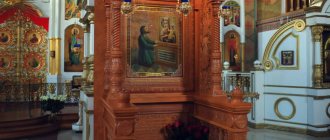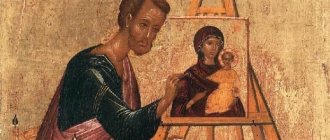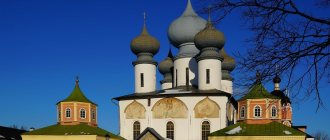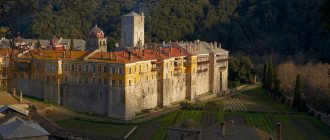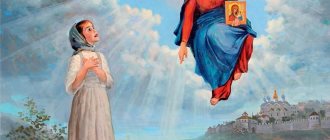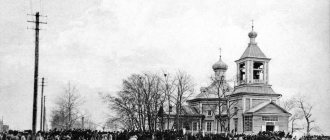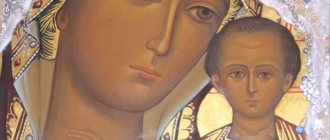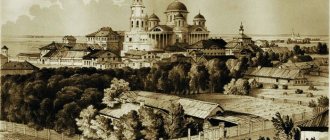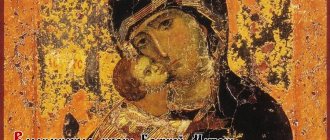Smolensk Icon of the Mother of God: history of origin
According to legend, the Smolensk Icon of the Mother of God was painted by the Evangelist Luke (1st century) for Theophilus, the ruler of Antioch. Since the 5th century, it was located in Constantinople (modern Istanbul, Turkey) in the monastery of Panagia. Many believers came to worship the icon of the Mother of God. The temple where she was located was nicknamed Odigon, which is translated from Greek as “Guide”. The icon was called “Hodegetria” (Guide).
On the territory of Rus' this image appeared no later than the middle of the 11th century. There is a version that it was given as a blessing for the marriage of the Byzantine princess Anna with the Chernigov prince Vsevolod Yaroslavich. Their son, the Kiev prince Vladimir II Monomakh, transferred the miraculous image to Smolensk in 1095. In the city, the Assumption Cathedral was built especially for him in 1101. From that time on, the icon began to be called Smolensk, after the place where it was the Guardian of the city for nine centuries.
Smolensk Icon of the Mother of God
Description of the icon
The Mother of God is most often represented in a half-length image, but there are also full-length and shoulder-length versions, for example, the Kazan Icon. The Baby can be located either to the right or to the left of the Virgin Mary; more often He is depicted sitting on the left hand of the Blessed Virgin.
The composition of the Hodegetria iconography is as follows: the Mother of God and the Infant Christ are depicted almost frontally, their faces facing the praying person do not touch. The head of the Mother of God may be slightly inclined towards the Son, the hand raised in a prayer gesture at chest level.
The Blessed Virgin is dressed in crimson (on modern lists often red) clothes, which emphasizes Her status as the Queen of Heaven. Jesus is also in a royal robe of golden color, that is, in the image of the Almighty. The Divine Infant sits in the arms of the Mother; With his right hand He blesses, with his left He holds a scroll, and less often, a book.
On her left hand the Mother of God holds the Baby Jesus, and with her right hand she seems to point to Him. The meaning of this gesture is that the Guide points the way to salvation through Jesus Christ.
In terms of iconographic type, the Smolensk Icon of the Mother of God is one of the oldest editions characteristic of Byzantine writing.
Lists
According to one version of the legend, the icon written by the Apostle Luke and brought from the Holy Land ended up in the Blachernae Church, where there was also a healing spring and where other shrines were kept: a robe and part of the belt of the Virgin Mary. Perhaps one of the copies made from the original icon by the apostle was placed in the Blachernae church. It is known that several copies were made from the original image , which became famous for miracles. In any case, in the Blachernae Church there was a particularly revered icon of the Mother of God Hodegetria.
Numerous copies of the miraculous image of the Mother of God Hodegetria were sent to all parts of the empire and beyond. From Byzantium, the iconographic type of Hodegetria came to Rus', where, based on the place of creation, stay or miraculous discovery, similar icons received names: Toropetskaya, Smolenskaya, Tikhvinskaya, Iverskaya, Sedmiezernaya, Kazanskaya.
Veneration of the Smolensk Icon in Rus'
In 1239, when Batu’s horde was approaching the west of Rus', the Mother of God showed Her protection through the Smolensk icon. A pious warrior named Mercury heard the voice of the Mother of God from the Smolensk icon. The Blessed Virgin ordered to raise all the townspeople to defend the city. On the night of November 24, the enemy army plans to surprise the city. All residents of Smolensk came to the defense. Mercury himself fought fearlessly and fell in an unequal battle. Subsequently, the warrior was canonized. On the day of his death, a thanksgiving prayer began in front of the Smolensk icon.
In 1395, Smolensk fell under the rule of the Principality of Lithuania. And in 1398, the Smolensk Icon was brought to Moscow as a dowry for the daughter of the Lithuanian prince Vytautas Sophia. The place of its storage was the Annunciation Cathedral in the Kremlin. But in 1456, Smolensk residents begged the Moscow prince Vasily the Dark for their shrine. On July 28 (August 10, new style), Muscovites saw off the venerated image of the Mother of God in a religious procession. A list (copy) of the icon was left in Moscow. After this event, a festive religious procession from the Kremlin to the Novodevichy Convent began to be held annually. The monastery was built precisely on the site of farewell to the Smolensk shrine.
In 1514, the day after the celebration of the Smolensk Icon (July 29), Russian troops took Smolensk by storm. The city returned to the Russian state.
Currently, the location of the original Smolensk icon is unknown. After the liberation of the city of Smolensk from the Nazis in 1943, this image disappeared without a trace.
Now in the Assumption Cathedral of Smolensk there is a list of the miraculous icon of the 17th century.
The history of the appearance of the holy image
The image is very ancient; it is no longer possible to establish exactly how it ended up in Russia. But most historians agree that the icon was brought from Byzantium. There she was known as the defender of Constantinople, which was often raided. It is believed that one of the daughters of the Byzantine emperor married a Russian prince. As a dowry, the princess brought the shrine with her in 1046.
Actually, the type of “Guide” was formed in the first centuries of Christianity in Palestine. From the most ancient image, several copies were made, which were distributed throughout the Christian world. The “Smolensk” icon of the Mother of God “Hodegetria” began to be called after Vladimir Monomakh moved it to this city. The icon was placed in a specially built temple.
Work as a courier at Yandex.Eda (up to 3,400 rubles per shift) leave a request →
In the 15th century Smolensk was captured by the Lithuanians. Heading to Moscow, one of the lords took the shrine as a gift. So she ended up in the Annunciation Cathedral of the Kremlin. There are other versions of this event:
- The icon was brought by the exiled Smolensk ruler.
- The Lithuanian prince gave the image to his daughter, who was married to the Moscow ruler.
- The Tatars took the icon away.
One way or another, the shrine remained in Moscow for some time. In the middle of the 15th century. On behalf of the bishop, the ambassadors turned to the Grand Duke - they begged to return the “Smolensk” icon of the Mother of God. People firmly believed that without her intercession they would not be able to resist numerous enemies. The prince saw this as an opportunity for unification, so he allowed the image to be taken out. But first it was decided to make an accurate list.
Feast of the Smolensk Icon of the Mother of God
Every year on August 9-10, Smolensk celebrates a holiday in honor of the Smolensk Icon of the Mother of God. On this day, ceremonial events are held. Since 2016, the city has hosted the Odigitrievsky international bell ringing festival. Also on these days, fairs of decorative and applied arts are organized.
The celebration of the Smolensk Icon of the Mother of God is established several times a year. August 10 - in memory of the return of the miraculous image from Moscow to Smolensk. November 18 - in memory of the Russian victory over the French in 1812. December 7, new style - in memory of the defense of the city of Smolensk from the attack of Batu’s troops.
Smolensk Icon of the Mother of God: revered lists
The revered Smolensk Icon of the Mother of God (list) is kept in the Assumption Cathedral of Smolensk. The history of this copy begins in 1602. It was located on the fortress defensive wall of the city. During Napoleon's invasion in 1812, this miraculous image was in the camp of the Russian troops. After each victory, a thanksgiving prayer was served in front of the Smolensk icon. On the eve of the Battle of Borodino, a religious procession was held. And after the complete victory over the French, the miraculous image returned to Smolensk.
In 1831, during a cholera epidemic, a fresco image of the Smolensk icon, dating from the 14th century, was discovered above the entrance to the Novgorod Church of the Transfiguration under a collapsed layer of plaster. The appearance of this image was perceived by believers as the revealed mercy of the gracious help of the Mother of God. Soon the epidemic in the city stopped. In 1848, when a new wave of epidemic broke out, a copy of this image was painted. People nicknamed her “Cholera” - many residents turned to her for help and received healing from cholera.
Smolensk Icon of the Mother of God: what they pray for
The Smolensk Icon is considered the Patroness of home and family. Believers turn to the Most Holy Theotokos in front of Her miraculous image with a prayer for the well-being of family life, protection of the home from enemy machinations, and for material well-being. Also, before this image, they pray for those traveling, so that the Mother of God will protect them from troubles and misfortunes along the way.
But it should be remembered that there are no special icons for certain prayers.
“He who has pure and strong faith in the gracious power of the Most Holy Theotokos can successfully offer prayer before every icon of Her, because the prayer offered ascends to the Most Holy Theotokos Herself and, by faith, can bring down Her gracious power and help to a person” (St. Philaret of Moscow, 1783 -1867).
Holy patron
The veneration of the Mother of God is especially characteristic of Orthodoxy and Catholicism; there are many holidays for worship, hundreds of images are written. How does the “Smolensk” icon help believers? If you remember the name of the iconographic type, you can understand the most important meaning of the writing: the Blessed Virgin guides and guides the heart of a person, showing him the right path to heaven - through Christ. Accordingly, this image can help those who have little faith.
Given the history associated with many decisive battles, the icon is the patron saint of all those in military service. They pray to her while traveling. It will also help you make the right decision in an uncertain situation. It is believed that the image patronizes the family, since it is strongly associated in the popular consciousness with security and protection from attacks. Will help make peace between warring parties.
Miracles from the Smolensk Icon
Particularly revered by believers, the Smolensk Icon of the Mother of God became famous for various miracles. Many of them are still not documented.
On December 6, 1986, in the Church of St. Nicholas the Wonderworker in Chicago (USA), tears flowed from the Smolensk Icon of the Mother of God. Many believe that this is how the Most Holy Theotokos called for maintaining the purity of the Orthodox faith in America.
In 1935, a parishioner brought the Smolensk Icon to the St. Guryev Church (village of Petyal, Mari El Republic). At this time, a spring began to flow near the temple on the hillside. Before, according to local residents, it did not exist. The miracle of the appearance of a healing spring was associated with the manifestation of the mercy of the Most Holy Theotokos. Now many believers receive healing from nervous and mental illnesses from this source. There are reports that in the 1990s, some women observed the appearance of the Mother of God at the Smolensk spring.
Iconography
There is little information left about the iconographic features of the image, since the icon, as is known, was lost in 1941, and therefore no one studied it. It was only known that the icon board was very heavy, the ground was made of chalk with glue, as was done in ancient times, and covered with canvas.
The Mother of God holds the Child in her left hand, the Lord’s right hand is raised in a blessing gesture, and in His left hand is the “scroll of teaching.” On the reverse side were written a view of Jerusalem, the Crucifixion and an inscription in Greek - “The King is Crucified”. In 1666, the icon was renewed, and later images of the Most Pure Mother and John the Evangelist appeared at the Crucifixion.
The iconographic image of the Smolensk Icon is very similar to the Iveron Icon of the Mother of God, but differs in the severity of the arrangement of the figures and the expression of the faces of the Mother of God and the Infant.
Prayer before the Smolensk Icon of the Mother of God
Oh, Most Wonderful and Highest of all creatures, Queen Theotokos, Mother of the Heavenly King Christ our God, Most Pure Hodegetria Mary! Hear us sinners and unworthy at this hour, praying and falling before Your Most Pure Image with tears and tenderly saying: lead us out of the pit of passions, Most Blessed Lady, deliver us from all sorrow and sorrow, protect us from all misfortune and evil slander, and from the unrighteous and fierce slander of the enemy.
You may, O Our Blessed Mother, save Your people from all evil and provide and save You with every good deed; Do You need other Representatives in troubles and circumstances, and warm Intercessors for us sinners, not imams? Pray, O Most Holy Lady, Thy Son Christ our God, that He will make us worthy of the Kingdom of Heaven; For this reason, we always glorify Thee, as the Author of our salvation, and extol the holy and magnificent name of the Father and the Son and the Holy Spirit, glorified and worshiped God in the Trinity, forever and ever. Amen.
